The Happy Years Are Here Again

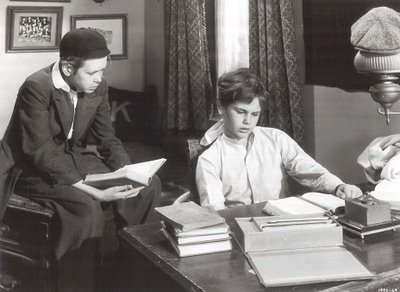
The Happy Years Are Here Again
Greenbriar today revisits a column from way back in 2007 that celebrated a time even further back from early in the twentieth century when boy's schooling was something it never would be again. 2007 text is updated with yellow-highlighted comments in part result of seeing The Happy Years again recently, a wedding of GPS old and new to also appreciate reader input from '07 that, as always, enhanced whatever I had to say with fresh info and insights. Thanks much to you readers for that. Sometimes a good picture can be jinxed by a campaign that refuses to jell --- then there are those left at the starting post as sales personnel devote themselves to more promising stock. Everything fell apart for The Happy Years from the moment it was trade-shown on May 24, 1950. MGM had unveiled Annie Get Your Gun to showmen the day before, excitement building too for Father Of The Bride. These were leviathans that would roll over The Happy Years, and all these years later, it’s still on the canvas. We can only guess what went wrong, though trade scribes hinted at the problem. Ads covered with type and cluttered posters, said The Manager’s Round Table section of The Motion Picture Herald --- very little illustration, so you have to read to get the point. One-sheets were uninspired, as shown here, and limited to headshots of an unpresupposing cast. What exactly was Metro selling? No one seemed to get a handle on how to exploit The Happy Years. It was based on "beloved" stories that had run in The Saturday Evening Post over the last eleven years, but was Post reader familiarity enough to get back $1.3 million spent on a Technicolor period piece? These were hard enough to merchandise with stars aboard (witness The Tall Target), so how to excite patrons over a boy’s prep school at the turn of the century? The Happy Years headed double bills with another MGM forfeit, Mystery Street (loss --- $277,000). This is a grand picture and deserved better results, said one manager concluding his dispirited run of The Happy Years. Worthy shows had been dumped before and would be again, east coast Leow's sales having shrunk from a job too challenging for customary comfort. A Father Of The Bride or Annie Get Your Gun, let alone King Solomon's Mines, virtually sold themselves and saw considerable grosses, while The Happy Years withered in the heat of summer playoff to finish with an egregious $680,000 in domestic rentals, plus $179,000 foreign. Fact to face was a public indifferent to mirror upon days past that was The Happy Years, for though it dealt in exploits of adolescence, these were not adolescents to reflect experience of teens attending movies in 1950, latter by then, and by far, the dominant age group buying tickets. Let their needs be met by A Date With Judy, or something of like, current-set, time. A million-dollar loss was recorded for The Happy Years, and there would be no re-issues, other than a few bookings among MGM's Children’s Matinee series of the early seventies where it was re-titled The Adventures Of Young Dink Stover. Those who cared might have seen The Happy Years previously on television, as it had gone into syndication for Fall 1964 with 39 other post-48 Metros. The (very) few prints in circulation among collectors were either heisted from Films, Inc. or some TV station. I’ve not yet met anyone who didn’t like this picture. Occasionally there are sightings on TCM, but otherwise The Happy Years is orphaned. There’s never been a video release. Warner Archive adopted The Happy Years in 2010, a nice transfer. Amazon has it for $9.99, half what I gladly paid eleven years ago. I’ve watched interviews with Dean Stockwell in hopes it would be mentioned, more lately a sit-down he did with TCM accessible on You Tube, a good interview despite The Happy Years not coming up over its forty minute length.
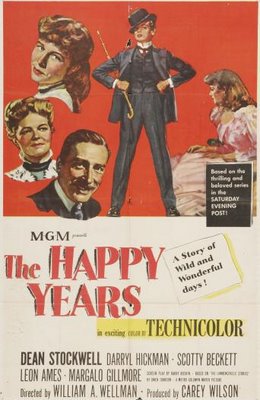
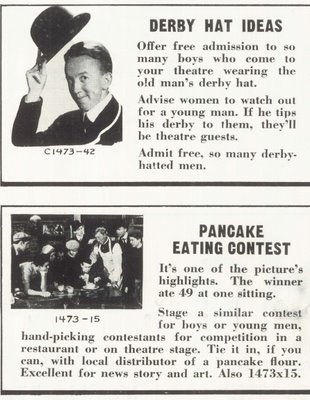
My father attended a boy’s school very much like Lawrenceville, the setting of The Happy Years. He particularly enjoyed the picture when we saw it on the old SFM Holiday Network presentation around 1981, but is there anyone left who would understand, even remotely, the student’s life he identified with? This was truly a movie for men who’d come of age near the turn of the (past) century. No one born since could comprehend, nor dramatize, that world so well. Producer Carey Wilson, born 1889, was enamoured of the project, having been a faithful reader of the Lawrenceville stories. Chances are he attended a place very much like it. Director William Wellman had been an outstanding athlete in high school, though it’s been suggested he never finished. He was born in 1896. These men brought old-world sensibility to The Happy Years. Both were fascinated by the culture of a boy’s academy. I’ve not experienced a place such as Lawrenceville, but details seem authentic. I’d like to think my father’s sojourn at the McCallie School in Chattanooga, Tennessee was similar. He boarded there in the late 1910's. The night we watched The Happy Years, he surprised me by turning to say at the end, and meaningfully, "Now that was a good picture," a reaction no show had gotten from him in my memory. Maybe his own experience in The Happy Years milieu roused memory of its larger truths. It took men of a certain age to appreciate crucial distinction between gerunds and gerundives. I have been reading a compilation of letters that Raymond Chandler sent to various publishers, fellow authors, readers, etc. "Hard-boiled" Chandler spent formative school years in England, where he received classical instruction in Greek and Latin. He took great pride later for having had what he regarded as proper education, crediting this for skills doing fiction. I took Latin in high school, made a muck of it, a fact regretted the more as traditional education seems increasingly imperiled. Is Latin taught anymore ... anywhere ... let alone Greek? Distinction between gerunds and gerundives seemed odd to a point of being comical in the late 60's when I first saw The Happy Years and was failing Latin. More and more I realize, however, that the joke was on me, Raymond Chandler a useful reminder of that fact. Ever wish you could go back and re-do school the right way? I dare say my second chance might well begin with a Latin course, one taken for serious this time.
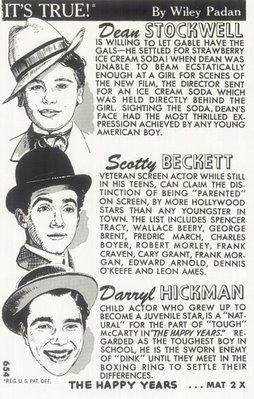

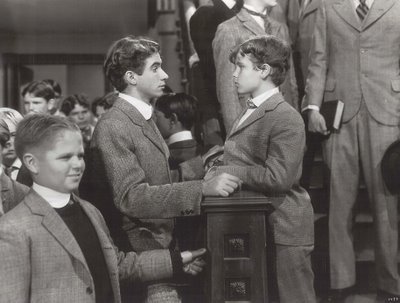
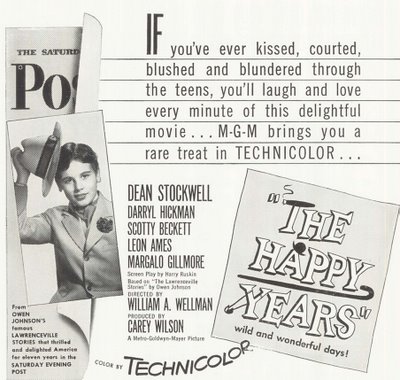
Youthful roles for Dean Stockwell, Darryl Hickman, and Scotty Beckett were nearly exhausted when they did The Happy Years. No longer boys in a cute sense, they were deep into adolescence and complications that implied. Scotty had been arrested the year before for driving drunk. By the time The Happy Years went into production, he was twenty years old and married. The easy charm he projects in the movie was something he had plenty of in real life. It got him (barely) out of tough scrapes over a tumultuous adulthood until his luck ran out with a probable suicide (his third attempt) in 1968. Dean Stockwell was younger --- thirteen at the time The Happy Years was shot. This was his peak period, but late in the post-war day for child players to enter the game. He had the distinction of appearing in two classics released within weeks of each other --- Stars In My Crown and The Happy Years, but kid pictures of the kind MGM routinely turned out during the thirties and forties were disappearing fast, and Stockwell would only have a couple left before withdrawing for several years to wait out puberty. Darryl Hickman was gangly and well past boy parts at eighteen, had been in movies since If I Were King in 1938. He was on a TCM child star panel some years back and gave a good account of himself. I found it hard to believe someone so youthful in appearance and attitude could be seventy-five as of 2006, and is ninety today. He wrote a book that has received praise.



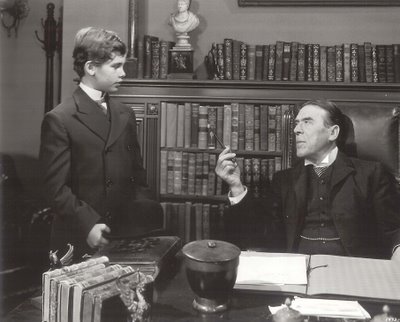
Variety suggested trims. The Happy Years was leisurely and, some said, overlong. It is relaxed as to pacing, but wasn’t life itself so in vanished days depicted? I’d not vote to remove a moment of these 110 minutes. Life as idyllic in a final decade of the nineteenth century had great currency among those who wrote from point of view of a twentieth. Not many authors who latterly made names for themselves failed to unpack precious memories accumulated during youth. Even a caustic observer like H.L. Mencken let guard down to bask in joy that was his boyhood past in Baltimore. Books written in a first half of the twentieth century to meander in spent days of the nineteenth could make up a genre in themselves. Patriarch of Happy Years choice Leon Ames is on hand, his a comforting presence as is the familiar Meet Me In St. Louis house (even against a beach set matte painting). These link The Happy Years with nostalgia exercises done previous by Metro. The St. Louis house itself became a touchstone for memories kept from movies held close, a reflection of family life idealized, if not fancifully beyond what most of artists knew, or could ever know. Not a few found comfort that was missing from their lives otherwise, "escape" a best and sometimes most urgent reason for attending. Films from the Classic Era understood this need, and ministered to it. Red Skelton’s Excuse My Dust of the following year would utilize the same standing sets, much of furniture seen in The Happy Years used again here. Celebration of times past prevailed also at Fox with Cheaper By The Dozen, and Warner’s Booth Tarkington stories accommodated Doris Day’s formula for On Moonlight Bay and By The Light Of The Silvery Moon. These revolved around similar period of American history. There must have been a fifties consensus that life in the nineties was simpler (if not preferable). Will we look back on any decade of the twentieth century with as much nostalgia? For a while, it seemed the sixties would reclaim us. American Graffiti ushered in 70's longing for drive-ins and sock hops, but that era seems now like ancient history. Why would movies embrace the nineteenth century again? Might as well revisit lives of the pharaohs , and that is all a more reason to treasure The Happy Years. We are not going to get pictures the likes of this again. People who could mount them are gone and they did not leave instructions behind.
19 Comments:
What a great tribute to a forgotten movie, although I must admit at first I thought it meant MGM had made a movie out of Mencken's memoir of roughly the same era, Happy Days. Now that would have been something to see, but unlikely...
The early days of nuclear weaponry... possible war with the USSR and China... real war with Korea... juvenile deliquency... yeah, I can understand why there'd be nostalgia for a time when it appeared the only problems concerned shoveling up after the horse-drawn carriages. One's memories tend to focus only on the good. My kid's almost 11 and I know she'll look back at the good old days of the early 21st century.
John,
You know one can experience a slower-paced good old days life, and every map is full of those places:
Small Town America--those small pockets remote in every state where the horrible giants of Wal-Mart, McDonalds, etc haven't invaded yet and spoiled the charm--I can think of small towns in Vermont that one could shoot a gay-90s--or Revolutionary War movie in....
ec,toledo
Hi, John -- I think the entire industry was jumping on the "turn of the century" bandwagon. America had reached the half-century mark and was looking back nostalgically at the century's beginnings. Fox had "Cheaper by the Dozen," Allied Artists had "There's a Girl in My Heart," Warners had the Robert Youngson compilation feature "Fifty Years Before Your Eyes." M-G-M's contender seems to have been "The Happy Years," and without major Metro names for the marquee, it may have been greeted as just another period picture in a season filled with them.
And, as you mentioned, exhibitors were saving their premium rentals for M-G-M's "Annie Get Your Gun" and "Father of the Bride," and probably didn't want to shell out M-G-M prices for "The Happy Years." (Now if, say, Columbia had made "The Happy Years," more exhibitors might have taken the bait, along with the lower rental fee.)
The Adventures Of Young Dink Stover.
You've got to be kidding me.
I just wanted to say "Leo G. Carroll". You've got pictures of him all over the current entry, and yet he's not mentioned in the text or on the posters. So....Leo G. Carroll. That's all!
I too enjoy watching THE HAPPY YEARS...and in fact, the Lawrenceville School ended up making a major impact on Hollywood, thanks to a member of the class of 1960, one Michael Eisner--the man who turned Disney from an institution into a titan.
The small screen also has Lawrenceville to thank for Brandon Tartikoff, class of '62. During his tenure one of the resident faculty had a young daughter who was the campus mascot...Punky Brewster.
Tartikoff paid her for the right to use her name for the title/lead character of the series he put on NBC (and the lead character's pet dog was named Brandon).
Even pop music has a Lawrenceville grad's contribution...Hugh Anthony Cregg III '67, better known to the world as Huey Lewis.
Paul, this is wonderful information! Thanks so much for supplying it, along with your insightful comments on other Greenbriar archive posts.
Howdy, my mother was working as a secretary in Lawrenceville, N.J. during the time of production and took a picture of Stockwell sitting in some kind of horse-drawn buggy. If you like I can scan it and send it to you.
I really love this film and glad that Warner Archive released in on DVD. I know a lot of William Wellman fans don't care for it, but for me it's highly enjoyable. All three leads are very talented and entertaining, and it's sad that Scotty Beckett met such a tragic end, one of those child actors who undoubtedly never recovered from the exploitation and abuse that many young performers were subjected to. It's a shame that he became so self-destructive as he was very talented. Dean Stockwell has had an amazing career, and I love that he's still acting today. Darryl Hickman has also done very well for himself, as has his brother Dwayne (who by the way, plays one of the boys in the sequence where Dink returns home and he and his friends pull pranks on neighborhood girls). I have heard that Dean Stockwell has named this movie as one of his favorites of his childhood acting career, as it was a comedy and light-hearted and didn't require him to cry.
Great post with lots of photos and info!
Thanks very much for your comments on this post that dates back --- wow --- nine years. Glad to know the old Greenbriar articles are still being enjoyed.
Some time ago here "One Sunday Afternoon" was discussed, that Gary Cooper film feeling downright gritty next to the gingerbread remake "Strawberry Blonde". A second remake with Dennis Morgan was half-hearted at best. Maybe there's a precise distance where the past acquires maximum sheen.
Disneyland's Main Street was nostalgia for a lot of adults when the park opened in '55. Now it's as much of a fantasy as the rest of the park -- "real life" Frontierland and Adventureland were even then more evocative of old movies than history, an effect amplified by time. Disney may have been the last to sell the period as nostalgia rather than historical period, with "So Dear to My Heart" (a personal valentine to a few years of childhood on a farm), "Lady and the Tramp" and "Pollyanna" (the last two in "Strawberry Blonde" mode).
Note that Harry Potter was a fantasy not just of wizardry but of a highly idealized boarding school. It resonated like crazy with a generation that had zero experience of such schools.
I saw this a while ago and came away distinctly unimpressed, which was especially disappointing since I had so loved the PBS adaptation in the late 80s. Granted, PBS had more space to devote to the stories, but I came away so taken with them that I bought the tie-in book.
Of course, I also bought the book after I saw "Earthworm Tractors," so who knows?
Griff consider how or why THE HAPPY YEARS came up short at the boxoffice:
Dear John:
I was fascinated years back by your coverage of this underrated, underseen Wellman film, and I found your update this week quite interesting all over again.
I first saw this many years ago on a black-&-white set; later, when I eventually saw it in color, I was unprepared for its careful, tasteful use of Technicolor and its subtle period look. I think many basically expect this to be a mannered, twee story with a long-passed expiration date, but it's smarter and wittier and, yes, tougher than that. But it is certainly from another time.
I found a 1949 Thomas Pryor NY Times article about the location filming at Lawrenceville. But I could find no record that the Times ever actually reviewed the movie when it came out. As you note, HAPPY YEARS was no programmer and not a cheap film by any means, but perhaps MGM had some cold feet regarding the completed picture and simply decided against big urban promotion and ballyhoo. Perhaps that explains why Metro didn't bother to do the obvious and expensively commission a handsome Norman Rockwell or J.C. Leyendecker illustration to use to tub-thump its adaptation of Johnson's famed Saturday Evening Post-published stories.
I don't believe this opened in a Broadway house -- the Times would have had to have a reviewer cover that sort of major release. In his book about his father, William A. Wellman, Jr. wrote that "the studio lost interest in it, as little advertising money was spent... (it) found fewer theaters than a normal MGM release." He notes that the film went out mostly in double-bills.
I remain amazed that Metro got a plush mid-1950 Radio City Music Hall booking for the well publicized Wellman/Schary low-budget experiment THE NEXT VOICE YOU HEAR; the little movie was quickly shot and completed after THE HAPPY YEARS was finished, and opened before YEARS was released. By contrast, the elaborately produced period family picture -- which would have seemed an ideal film to play the Hall -- received short shrift.
Regards,
-- Griff
Regarding the "House of Rothschild" photo atop the page: it never ceases to amaze me what a knockout Loretta Young was back in the day.
And George Arliss was an early Cary Grant.
The Disney movies D. Benson mentions, at the time the were in theaters, represented an idealized vision of "grandpa's ( and/or grandma's) world" to the tykes brought in to see them.
I suppose movies set in the 1950s and 1960s with a similar rose-tinted nostalgic vibe for those times could be made for kids today, if somebody really wanted to follow Walt's model. But was Walt really aiming at the kids with these? Or was he being a little self-indulgent?
It does seem to take at least fifty or sixty years to pass for any era to be able to bear that "golden days of yesteryear" patina for the younger set of viewers or readers, but for the older viewers, nostalgia requires that they were actually alive during the times being represented, for nostalgia requires memory for it to exist. Evocations of nostalgia cannot be what the kids got from those Disney movies.
In general, once an era passes out of living memory, nostalgia for that era ceases to be a possibility; but people have been living longer lately, so maybe nostalgia has had similar extension of its shelf life.
Dean Stockwell has just passed.
Craig Reardon checks in re some encounters with Dean Stockwell:
Your post on the MGM film "The Happy Years" was well timed, if in a melancholy way, due to the recent passing of its one-time child star Dean Stockwell. I got to meet and work with Dean on a TV mini-series I began (but was fired from, due to the most ridiculous reason: a pointless conflict, not initiated by me, with the head hairdresser--who was the producer's wife! Go figure--and the thing eventually went on to win Emmys for all the short-time replacement makeup people!) based on a best-selling account of the fabled Battle of Little Big Horn, "Son of the Morning Star". Stockwell played Phil Sheridan, apocryphal [?] author of the [currently] distasteful if not downright despicable remark, "The only good Indian is a dead Indian", if memory serves. Not in this one, though (he doesn't say it in this account.) I recall that Stockwell wanted to consult with me about a couple of things prior to the production starting up in Montana, and arranged to meet with me locally here in Agoura Hills, which is not too far from where he lived somewhere in Malibu. We met at a barbecue place, and to my surprise he had invited someone he referred to simply as an old friend...who turned out to be Billy Gray! Can you imagine that? Sitting across from these two former child actors who'd appeared before millions?! Surreal, to a veteran couch potato and pop culture addict--at least in my own fashion--like myself. Dean was serious in demeanor, at least in our dealings, but what I liked about him was he was very straightforward, and a gent. No showbiz B.S. in any negative way, even with his incredible bona fides: an entire lifetime spent in the business. More than I can say for some younger and far less experienced than he was, who I sometimes had to struggle with.
Post a Comment
<< Home